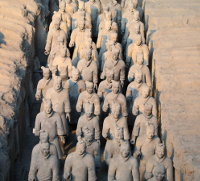|
Natural Causes Preserved Terracotta Army's Weapons: Study
April 4, 2019
Scientists say that natural elements, not some ancient precursor to anti-rust technology, kept the Terracotta Army's weapons intact all these years. The very large collection of armed soldiers was discovered in 1974 by a group of farmers digging a well. Made up of more than 7,000 life-size clay sculptures of armed warriors, the army guards the tomb of China's first emperor, Qin Shi-huang-di, who died in the 3rd Century B.C. Not long after the discovery, scientists found traces of chromium salt oxide, a substance now known to resist rust, on some of the weapons held by the warriors. Some scientists formed the theory that the Chinese knew of chromium's anti-rusting properties all those years ago. However, new analysis done by a team led by Marcos Martinon-Torres of the University of Cambridge has found chromium on only 37 of the 464 weapons tested. Further, the weapons that did contain traces of chromium had it near the base of the figure, close to the sword hilt or arrow or spear handle–not on the hilt of a metallic sword or the point of a metallic arrow or spear. All of the weapons tested showed the same small amount of corrosion, despite their advanced age. As it turned out, the chromium traces found on weapons came from the lacquer coating given to the warriors and weapons before they were painted with pigments. The real cause of preservation, the scientists said was in the soil itself and the surrounding air. They proved this by using an environmental chamber to simulate weathering of replica bronze figures: those buried in the same soil found in Xi'an, where the Terracotta Army was found, showed next to no signs of weathering after four months of extreme temperatures; by contrast, similar figures buried in soil commonly found in the U.K. experienced severe corrosion. |
Social Studies for Kids |
Social Studies for Kids
copyright 2002–2024
David White





